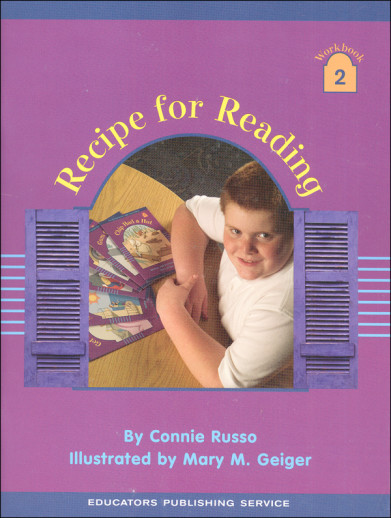We use cookies to make your experience better. To comply with the new e-Privacy directive, we need to ask for your consent to set the cookies. Learn more.
Recipe for Reading Workbook 2
The eight Recipe for Reading student workbooks, written by Connie Russo, provide extended practice on the phonics concepts introduced in the manual. Workbook 3 corresponds to Lessons 1731. There are 5 to 8 practice pages for each skill, and activities include phonemic awareness, encoding and decoding, and short, decodable stories. The workbooks can be used with any phonics or core program as additional practice.
From a publisher you can trust - Educator's Publishing Service (publishers of Explode the Code) - here's a three-year phonics/reading program based on the Orton-Gillingham methodology that won't break the bank. Sound like a win-win? I think so. Targeting struggling readers but useable for all students, the teaching materials were developed for tutors. This means an easy transfer to the homeschool world. If you have a child who is struggling with learning to read - or who you suspect might be dyslexic, this is definitely a program to consider. If you just want a good, solid phonics/reading program, this is also one to consider.
Absolutely essential (reading the manual in its entirety before starting is emphasized), the Teacher's Manual provides an overview of the program as well as lessons for each of the 67 sounds that make up this program. There are 97 lessons which cover the sounds plus additional lessons for various syllabication rules, prefixes, and suffixes as well as review. Although there are sample scripted lessons, individual lessons are not scripted, but they are carefully laid out and coordinated with both the workbooks and the readers. Appendices include a Pretest, Syllabication Overview, a list of Prefixes/Roots/Suffixes, Cursive models and a glossary.
The black and white Workbooks provide review and reinforcement activities, usually several pages for each sound. While not glitzy by anybody's definition, they are clean-cut in their appearance. I found that I occasionally was unsure of the meaning of a particular picture but by looking at nearby pages there was usually an activity that made the meaning clear as the picture illustrations are often used several times in a series of workbook pages. For instance, one picture showed a student gluing something with excessive glue that created a mess. The first use didn't give me a lot of clues as to the word associated with the picture but the next page made it perfectly clear that the operative word was blob. There does not appear to be any sort of answer key to the workbooks either in the workbooks themselves or in the TM.
The Alphabet Series Readers provide reading practice geared to the phonogram presentation as well as questions designed to cover vocabulary, inferential comprehension, and personal response. Series 1 provide books 1-18 and is used with the first 33 lessons (Workbooks 1-2) covering consonants, short vowels, consonant digraphs, two-syllable compound words, and ff/ll/ss/zz.. Series 2 (books 19-36) is used with lessons #34 - #78 (Workbooks 3-7) and covers syllabication, consonant blends, ng/nk endings, syllable division, and magic E. The Series 3 books (37 - 39) include lessons #79 - #97 (Workbook 7) and cover alternative spellings and pronunciations, three-syllable words, 'schwa,' and affixes. The emphasis of this level is spelling rules and it illustrates the relationship between phonics and spelling. Handwriting can be included at all levels, and the workbooks provide reinforcement. Cursive writing models are included in the TM.
Other program components include the Sound Cards - 67 small black and white cards (2.75"x4") that feature the sound on the front side and a sample word on the backside - and the Sequence Charts - a pad of 50 copies of the sound presentation sequence designed to be used as a checklist (one per child). This same Sequence Chart is included inside the front cover of the TM. The Affix and Root Cards are 132 cards with color-coded borders: orange for Latin-derived, blue for Greek-derived, and green for Anglo-Saxon. Cards have a prefix, root or suffix on one side and the definition on the other. Lastly, the Lined Writing Paper is specifically designed for use with the program, the pack includes 100 lined sheets - 25 sheets each of paper with these rulings: 1 ½", 1", ¾" and ½".
This program provides the basics and leaves room for you to add creativity. It includes elements that I consider to be important - systematic phonics, lots of reading practice including words and phrases, an emphasis on learning the meaning of words as well as regular comprehension checks - but encourages flexibility, pacing geared to the child, and incorporation of multi-sensory applications. Its focus is on struggling readers and in fact, it's designed to give the child a feeling of success. Workbooks are sequential rather than grade-level and the readers can engage an older child. However, that same sequential presentation means that you could cover the entire program in one year with an on-target student as well as slow it down considerably to match the needs of a struggling student. The TM provides suggestions for scenarios involving both younger and older students. Workbook K is specifically designed for introducing young learners to the program. ~ Janice
| Product Format: | Softcover Book |
|---|---|
| Grades: | K-6 |
| Brand: | Educators Publishing Service |
| ISBN: | 9780838804926 |
| Length in Inches: | 11 |
| Width in Inches: | 8.5 |
| Height in Inches: | 0.25 |
| Weight in Pounds: | 0.4063 |


part of the series
I used them in the past. I just can not find them in my stuff. They are great for my students learning to read and sound out words.
I currently have the upper level books for this program. I am teaching younger students this year and need K,1,2 books.
I wanted to continue students learning after the first 1 books.